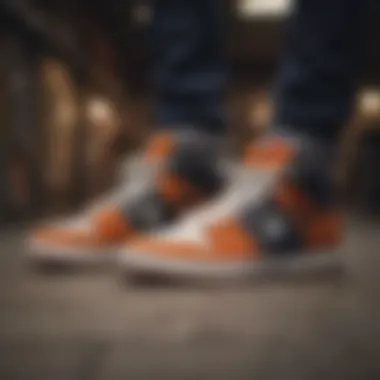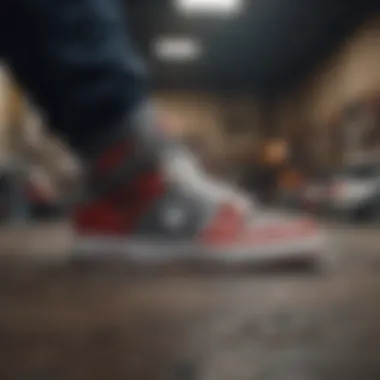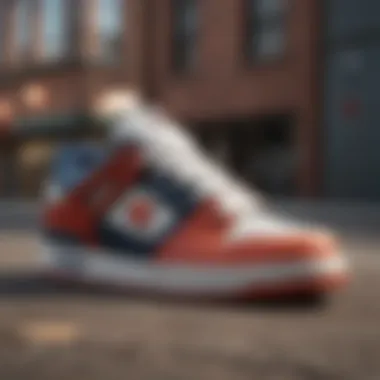The Cultural Impact of DC Shoes in the 90s


Intro
The 1990s were a lively time where youth culture blossomed like wildflowers in spring. Among the many elements that helped shape this vibrant decade, DC Shoes emerged as a standout player, becoming a cultural icon interwoven with the fabric of skateboarding and snowboarding. This article delves into how DC Shoes didn’t just cater to extreme sports enthusiasts; it also played a pivotal role in crafting the identity of a generation. Through its daring footwear designs and strategic marketing maneuvers, DC cultivated not only a brand but a lifestyle that echoed throughout the skate parks and snowy slopes.
Techniques and Tips
As DC Shoes forged its way into the hearts of young thrill-seekers, it introduced techniques not just in sports but in branding itself. Here we break down some of the aspects that made the brand resonate with so many.
Skill Development
The brand's collaborations with professional athletes provided insights into skill development for students of extreme sports. Not only did they create footwear that supported these athletes, but they also issued tutorials and tips through skate magazines and videos, making techniques more accessible. Enthusiasts learned tricks from the greats, which ultimately contributed to the burgeoning culture of skateboarding and snowboarding. The foundation laid out by DC did not stop at skate parks; it ignited passions far beyond those bound by ramps.
Practical Techniques
- Footwear Choice: Comfort and grip were really paramount. Riders and skaters were encouraged to choose styles like the DC Mikey Taylor or the DC Lynx for durability while performing tricks.
- Clothing Finesse: DC’s relaxed, yet durable apparel added to the aesthetic that separated skaters from the traditional sports look, further emphasizing uniqueness and style.
Common Mistakes to Avoid
- Overlooking Fit: Many individuals would go for flashy styles without considering proper fit. This could lead to uncomfortable experiences during sessions.
- Ignoring Care Instructions: Failing to maintain their shoes often meant a shorter lifespan for the equipment, reducing their overall performance.
The Evolution of Gear and Equipment
Gear didn't stay stagnant in the 90s; rather, it evolved along with the sports and lifestyles it encapsulated. DC Shoes was at the forefront, pushing boundaries and introducing innovations.
Essential Gear for Beginners
For those who dabbled in skateboarding or snowboarding during this exhilarating time, the essential gear included:
- Skateboard: A reliable board from trusted brands to get started.
- Protective Gear: Helmets and knee pads, crucial for safety while mastering skills.
- Shoes: Opting for DC Shoes ensured that the grip and performance were top-notch, catering to the needs of novices.
Latest Innovations and Trends
DC Shoes was not shy about pushing the envelope. The '90s saw the integration of new materials for better performance and durability. Shoes like the DC Pure featured enhanced cushioning, which was a game changer for athletes who faced rough terrains and high impacts.
Reviews and Comparisons
Consumer reviews often highlighted the comfort and stylish designs that DC Shoes offered compared to other brands. Many said that while other brands might focus more on aesthetics, DC balanced visual appeal with functional design to cater to the diverse needs of extreme sports athletes.
Safety Measures
With great thrills come inherent risks. DC Shoes recognized the importance of safety, growing along with the culture they nourished.
Essential Safety Gear
Investing in safety gear became increasingly vital for participants in extreme sports. Players learned from heavy falls and accidents, prompting a community-wide emphasis on safety. Basics included:
- Helmets: Protecting the noggin was a must.
- Wrist Guards: Essential, especially for skateboarders focusing on big tricks.
Best Practices for Safe Participation
- Know Your Limitations: It’s easy to get carried away, but understanding one’s limits reduces risk.
- Use Suitable Surroundings: Always practice in safe environments. Parks often had designated areas for beginners.
Injury Prevention and Management
Learning from injuries by athletes helped to inform many players. Stretching and warming up were often reiterated as crucial practices.
Spotlights on Extreme Sports
The 90s weren’t just about DC Shoes; they were also about the athletes who wore them. Profile of prominent athletes contributed to the brand's legacy in thrilling ways.
Featured Sport of the Month
Each month, the spotlight often shifted among various extreme sports. Skateboarding and snowboarding had their peaks, but it was BMX riding that sometimes stole the thunder with its unique tricks and stunts.
Profiles of Prominent Athletes
Many athletes like Danny Way and Colin McKay, who sported DC Shoes during their tournaments, helped validate the brand in the eyes of fans. Their styles and personalities went hand in hand with the aggressive aesthetic of DC Shoes, prompting younger generations to gravitate toward those identities.
"DC Shoes wasn't simply a product. It was a movement. It embodied the spirit of rebellion and creativity that every young person craved in the 90s."


Prelims to Shoes
The brand DC Shoes resonates deeply within the realms of extreme sports and youth culture, particularly during the transformative 1990s. This section aims to lay down the foundation for understanding DC’s significant role in shaping these vibrant communities. DC Shoes not only crafted an identity for itself, but also intertwined its narrative with the aspirations of countless thrill-seekers and adventure lovers of that era.
Founding and Early Years
Founded in 1994 by Damon Way and Ken Block, DC Shoes emerged from a simple yet compelling vision. It started in California, which was ripe with the burgeoning skate and snowboarding scenes. During those early days, the founders focused on crafting footwear that combined practical performance with cutting-edge style.
Their intent was clear: to produce shoes that withstand the rigors of extreme sports without sacrificing aesthetic appeal. The cultural backdrop of the 90s, marked by rebellion and creativity, matched the brand's ethos. It didn’t take long for DC to carve out its niche. Their aesthetic, often bold and colorful, became synonymous with the counter-culture that thrived among skate enthusiasts. It’s noteworthy that their early designs featured influences not just from skateboarding, but also from punk and hip-hop cultures, tapping into the pulse of youth culture.
The original lines of DC were thoughtfully designed to offer maximum support and durability, catering to skaters who pushed their limits day in and day out. For instance, the DC Lynx, which was launched shortly after the brand's inception, showcased this commitment to quality and innovation.
The Brand Vision
DC’s vision quickly evolved beyond footwear; it was about lifestyles, attitudes, and a spirit of adventure. The brand aimed to represent freedom and self-expression, resonating with a generation inspired by adrenaline-pumping activities and countercultural movements. The founders understood that they weren't just selling shoes; they were curating an experience, a community.
One of the keys to their brand vision was authenticity. The apparel and footwear were crafted in collaboration with sponsored athletes who were true skateboarders and snowboarders. This synergy ensured that every product launched spoke to the needs of its wearers while also reflecting their rebellious spirit.
Through strategic partnerships with pro athletes and a strong presence in skate competitions, DC Shoes solidified its status in the extreme sports domain. The imagery used in marketing campaigns—with skaters performing tricks in urban landscapes—painted a vivid picture of the freedom and exhilaration that the brand embodied.
"The essence of DC was never just about selling shoes; it was about igniting a passion that resonated across skate parks and snowy slopes."
By the late 1990s, DC Shoes had established itself as an iconic brand defined by its strong cultural ties and commitment to the extreme sports lifestyle. Their shoes became a badge of honor for those who embraced the thrill of skateboarding and snowboarding. In sum, the genesis of DC Shoes was not just a business venture, but a cultural phenomenon that helped define a decade.
The Rise of Extreme Sports
The 1990s marked a significant shift in the landscape of sports, particularly with the rise of extreme sports. This phenomenon didn’t just bubble up from nowhere; it stemmed from a growing discontent with conventional sports and a desire for individuality and self-expression among youth. The emergence of extreme sports like skateboarding and snowboarding provided a thrilling escape for many, allowing them to step off the sidelines and make their mark in a way that traditional sports didn’t quite allow.
As we delve into this era, it's clear that this rise didn’t just change how young people spent their weekends; it molded a whole new culture around adventure, rebellion, and community. This was a time when athletes weren’t just players; they became icons and luminaries of their domain. The connection between thrill-seekers and brands catering to their needs, like DC Shoes, solidified during this period. The importance of embracing individuality in this space cannot be overstated, as many athletes began to challenge the norms of athletic performance, promoting a mix of creativity and risk-taking that resonated deeply with the youth.
Skateboarding in the 90s
Skateboarding exploded into mainstream consciousness during the 90s, fueled by an exhilarating cocktail of innovation and subculture that resonated like a drumbeat in the lives of many teenagers. It wasn’t just about performing tricks; it was about carving out a lifestyle, creating identity, and making a statement. Skateparks began to sprout up in urban areas, and the sound of wheels on pavement became a soundtrack for a generation.
The skateboarding scene also began to see the emergence of professional competitions, showcasing extraordinary talents like Tony Hawk and Rodney Mullen. These events not only popularized skateboarding but also served as a launchpad for brands like DC Shoes, which saw an opportunity to tap into the adrenaline-fueled enthusiasm of a burgeoning community. Youngsters began to adopt the skate culture—fleeting trends in clothing, music, and lingo—all coalescing around a shared passion for riding. With companies like DC leading the charge, skateboarding evolved into more than just a sport; it morphed into a lifestyle movement that oozed coolness.
The shoes didn’t just serve a utilitarian role; they reflected the values of the skateboard community—freedom, rebellion, and style. Many youth saw skateboarding not just as a hobby but as a form of personal expression, a way to carve their niche in the chaotic world of the 90s. The skater's image, with its baggy pants and graphic tees, became instantly recognizable—a visual shorthand for a cultural revolution.
Snowboarding: A New Frontier
Just as skateboarding was reaching new heights, another exhilarating sport emerged, capturing the imaginations of the adventurous: snowboarding. Initially viewed with skepticism by the established skiing community, snowboarders broke onto the scene in the 90s with energy and flair. They brought a fresh edge to winter sports, trading in the rigid traditions of skiing for a more laid-back, fun-loving approach.
The allure of snowboarding lay in its combination of athletic prowess and creative freedom; riders could express themselves through their tricks and style in a way that was refreshingly original. As with skateboarding, snowboarders became trendsetters, and companies recognized this shift in consumer interest. DC Shoes saw the opportunity and embraced snowboarding wholeheartedly, developing styles that catered to both skate and snow environments.
An increasing number of competitions began to rise, creating their following and driving even more youth to the slopes. Snowboarding quickly evolved, seeing landmarks such as the 1998 Winter Olympics where it debuted as a competitive sport, further legitimizing its place alongside traditional winter activities. The thrill-seeking spirit of snowboarding captured the hearts of many, complementing the established skateboarding culture and further solidifying DC's stronghold in both arenas.
The dynamic shifts in winter and street sports helped create not just athletes, but cultural icons who opened doors for future generations in both skateboarding and snowboarding.
Overall, the rise of extreme sports in the 90s created a ripple effect that transformed how youth identified with athleticism. DC Shoes was pivotal in this shift, successfully tapping into both skateboarding and snowboarding cultures, creating a legacy that resonates to this day.
Shoes and Skate Culture
The symbiotic relationship between DC Shoes and skate culture during the 1990s is a significant part of the brand's narrative. The essence of skateboarding was not merely about the tricks or the adrenaline rush; it was also deeply woven into the fabric of youth identity and rebellion. DC Shoes arrived on the scene at a time when the skating community was burgeoning, bringing with it a fresh perspective and tangible support that resonated with the youth of that era.
Sponsorship of Pro Athletes
One of the standout strategies DC Shoes employed was securing sponsorships with pro athletes who were already legends in their own right. Names like Danny Way and Colin McKay were not only influencers on skateboards but also cultural icons for a generation that sought to emulate their heroes. In fact, Way's infamous leap over the Great Wall of China showcased not just his talent but the brand’s commitment to pushing boundaries—both in sport and style.
The financial backing of these athletes allowed them to focus exclusively on their craft. This was a game-changer for the industry, cementing the notion that skateboarding could be not only a sport but also a viable career path. In turn, the athletes’ notoriety elevated DC Shoes into the limelight, as youngsters aspired to wear the same kicks that their skateboarding idols sported. The brand effectively became a symbol of not just skate culture, but of determination and ambition.
Influence on Skateboarding Fashion
When it comes to skateboarding fashion, DC Shoes didn’t simply jump on the bandwagon; they drove the vehicle. The designs spoke volumes, blending functionality with flair. The bulky silhouettes paired with vibrant colors turned heads both on the streets and in skate parks. The shoes were not only about style, but they also provided excellent performance, crucial for skaters who were constantly testing their physical limits.
The brand's penchant for innovation directly influenced what young skaters chose to wear. Lines like the DC Lynx were quickly adopted and became emblematic of the skateboarding aesthetic. This wasn't mere happenstance; DC was intentional in aligning itself with the culture, understanding that skaters sought gear that resonated with their identity. The shoes became a canvas for expression, often adorned with graffiti and personalized designs, a rebellion against an unchanging status quo.
The Role of Skate Videos
Skate videos became the lifeblood of the 90s skate scene, and DC Shoes recognized the importance of this medium in driving their presence. These visual narratives weren't just collections of stunts; they were cultural artifacts. Companies would release videos, often featuring sponsored skaters in gritty urban landscapes, showcasing not only their skills but also the gear they wore—including the latest from DC.


These videos fostered a sense of belonging within a fragmented community. Watching a DC-sponsored skater nail a trick would inspire countless fans to pick up a board, all while keeping an eye out for that latest shoe drop. The well-timed releases of videos attracted both avid skaters and casual viewers, showcasing the extreme lifestyle in a raw, unfiltered manner.
Moreover, skate videos created an aspirational quality. Young skaters wanted the shoes worn by their heroes, believing that perhaps, just maybe, they'd ride like them once they laced up a pair of DCs. The feedback loop was powerful—each successful video release led to increased sales and deeper embedding of the brand in skate culture.
"Skateboarding transcended a sport; it became a lifestyle. DC Shoes capitalized on this shift, matching their mission with the heartbeat of youth culture."
In summary, DC Shoes' engagement with pro athletes, their influence on fashion, and their strategic use of skate videos all contributed to shaping skate culture in the 90s. Together, these elements crafted a narrative that was rich in rebellion and aspiration, making DC Shoes not just a brand, but a part of the identity for an entire generation.
Iconic Shoe Models
In discussing the cultural impact of DC Shoes during the 90s, one cannot overlook the significance of its iconic shoe models. These designs not only captured the spirit of the decade but also resonated deeply with the youth culture surrounding extreme sports. The shoes themselves became almost emblematic—symbols of the lifestyle that many aspired to live.
The designs were bold and unyielding, sporting bright colors and aggressive styles meant to stand out in a crowd. This wasn't just about function; it was about making a statement. They were essentially artifacts of a time when skateboarding and snowboarding were bursting into mainstream consciousness. Here are two models that left an indelible mark on the sneaker landscape:
- DC Lynx
- DC Court Graffik
- Launch Year: 1996
- Features: The DC Lynx was characterized by its chunky silhouette, reinforced toe cap, and padded collar. The cushioning offered excellent support, which suited skaters looking for durability. It was, without a doubt, built for performance.
- Cultural Relevance: The Lynx became synonymous with a particular breed of skateboarder who didn’t just ride; they owned the streets. It spoke to an era that celebrated raw talent and innovation in skateboarding tricks. This model carved its niche not just within skate parks but also in urban environments.
- Launch Year: 2005, but its roots and influence dig deep into the 90s.
- Features: With its striking graphic design and removable insole, the Court Graffik merged style and comfort seamlessly. The unique style made it a staple not just for athletes, but also for anyone drawn to the artistic expressions of sneaker culture.
- Cultural Relevance: Though it launched a bit later than the peak of 90s skate culture, the Court Graffik captures the essence of that time—a blend of sport, art, and the youth’s push against societal norms. The designs often carried graphics that spoke to the heart and soul of skateboarding, resonating with a generation that favored authenticity over conformity.
Through these models, DC Shoes didn’t just create products; it birthed legends that echoed through skate parks and city streets worldwide.
The Launch of the Lynx
The introduction of the DC Lynx shoe marked a watershed moment in the world of skateboarding footwear. Launched in the mid-90s, this shoe became the preferred choice of many skaters, thanks to its robust construction and performance-oriented features.
The shoe was crafted with the skater in mind, emphasizing durability and comfort. The padded collar lent support while the advanced cushioning system absorbed shocks from hard landings. This was not merely marketing hype; skaters found real benefit in its construction, leading to widespread adoption.
Beyond performance, the style was unbeatable. The Lynx gleamed in vibrant colors that caught the eye and sparked conversations, making it more than just a functional item. It became a part of a skater's identity, a badge of honor worn with pride.
The Lynx influenced a generation of skateboarders, setting the bar high for future models. As it hit the market, it built a community of loyal fans who revered its name long after it came out.
The Significance of the Court Graffik
While launched a bit later, the DC Court Graffik shoe in 2005 drew heavily from 90s skate culture, encapsulating its energy and spirit. The shoe’s tagline often echoed sentiments of breaking boundaries and expressing one’s individuality.
The unique graphics that adorned the Court Graffik made it a canvas for creativity, allowing wearers to showcase their personal style. This aspect became particularly appealing in the hip-hop culture of the early 2000s, where fashion was as much about self-expression as it was about the sport itself.
"The Court Graffik represented the convergence of skate culture and art, a duality that defined the era."
With its bold look, the DC Court Graffik appealed not merely to skaters but to anyone hooked on the vibrant lifestyle of the 90s. It became a cultural phenomenon, blending seamlessly into streetwear and enhancing the flashy visuals that characterized urban youth culture.
The ongoing influence of this shoe model is still felt today as it continues to resonate with both nostalgia and a contemporary audience looking for a connection to the past.
Overall, these iconic models illuminate the profound role DC Shoes played in shaping skate culture, each bringing its own unique flair and legacy to the table.
Marketing Strategies in the 90s
In the dynamic landscape of the 1990s, the marketing strategies employed by DC Shoes were like a breath of fresh air, capturing the essence of youth culture and the burgeoning world of extreme sports. These strategies not only put DC Shoes on the map but also carved a significant niche for the brand among its competition. The power of effective marketing efforts during this era cannot be overstated, as they effectively bridged the gap between the product and its target audience, making the brand more than just a name.
A crucial aspect of these marketing efforts was their inherent understanding of the youth psyche. By directly engaging with the demographic, DC Shoes transformed brand loyalty into a lifestyle. The strategic use of grassroots marketing efforts allowed the brand to connect on a personal level, fostering a community of thrill-seekers who truly resonated with what the brand represented.
Grassroots Marketing Efforts
Grassroots marketing was a cornerstone of DC Shoes’ strategy in the 90s. Rather than relying solely on traditional advertising avenues, the brand focused on building authentic connections with its audience. They immersed themselves in the skateboard and snowboard communities, gaining trust and credibility.
One notable example was their sponsorship of local skate parks and events, which made the brand a visible part of the culture. This hands-on approach enabled them to create a loyal and engaged following, turning enthusiasts into brand advocates. Furthermore, the brand often facilitated grassroots events, where they would actively involve pro athletes, thereby blurring the lines between the stars and the fans.
"When a brand shows up at your local park, it’s like they’re speaking your language. It felt like DC Shoes was one of us," a skater recalled during an interview.
The impact of such efforts was profound. By nurturing local talent and providing platforms for them to shine, DC Shoes not only strengthened its market presence but also elevated the entire extreme sports scene.
Use of Contests and Events
Contests and events served as another dynamic facet of DC Shoes' marketing playbook, effectively creating buzz and fostering community. By hosting competitions, they not only promoted their products but also elevated the sports themselves. One of their most notable contests was the “DC Skate Challenge,” which attracted skateboarding legends and up-and-coming talent alike, creating a collaborative festival of skill and style.
These events were more than mere showcases of athletic prowess; they were celebrations of culture, where visitors could immerse themselves in the exhilarating world of skateboarding and snowboarding. Participants were often given the chance to win exclusive merchandise, including the latest DC Shoe models, ensuring that attendees walked away with more than just memories.
- The contests were well-publicized through flyers and word-of-mouth, reaching the grassroots level effectively.
- They were designed to be inclusive, inviting skaters of all skill levels to participate and enjoy the thrill of competition.
- Engagement with local communities often led to repeat events, cementing DC Shoes’ reputation as a supporter of the culture.


Ultimately, these marketing strategies created a domino effect, whereby the brand's visibility increased through local engagements, leading to national recognition. By intertwining their identity with the pulse of youth culture and extreme sports, DC Shoes carved out a rightful place in the hearts of sneaker enthusiasts and adrenaline junkies alike.
The Cultural Context of the 90s
The 1990s were a decade of change, upheaval, and cultural awakening. It was a time when society started to move away from the corporate, clean-cut image of the previous decade, embracing ideals of freedom, self-expression, and rebellion. This backdrop influenced everything from music to fashion, especially within the realms of extreme sports. DC Shoes became a focal point in this transformative landscape, resonating deeply with the emotions and aspirations of youth.
Youth Rebellion and Identity
During the 90s, young people were not just passive spectators of culture; they emerged as active participants who were eager to craft their own identities. This very essence of rebellion against the traditional norms was intensely reflected in the actions and choices made by the youth of the time. Skateboarding and snowboarding—sports that were often seen as countercultural—provided avenues for this exploration.
DC Shoes tapped into this movement by creating footwear that discouraged conformity and celebrated individuality. The shoes were not merely functional but became a canvas where wearers could express their identities. The DC Lynx and other models were designed not just for performance, but to symbolize a lifestyle that rejected mainstream expectations.
Moreover, skating and snowboarding were infused with a certain rough-and-tumble spirit. Skate parks became microcosms of rebellion where kids gathered to challenge not only gravity but also societal norms. This set the stage for DC Shoes to position itself as an emblem for youthful defiance. The culture around these sports encouraged a mindset of “doing it your way,” which resonated with the idea of carving one’s own path.
Young people began to weave together different influences, mixing styles, and creating a unique fashion aesthetic, characterized by baggy jeans, graphic tees, and bold sneakers. DC Shoes emerged as a crucial player in this blend, often providing the footwear that completed the look. The alignment with youth culture did not stop at footwear; it stretched to the very core of how the brand communicated with its audience. Through music, art, and sports, DC Shoes became intertwined with a broader cultural fabric that defined the 90s.
This shift in identity was often represented by powerful symbols—shoes twisted and scuffed from use, mirroring the journey of each individual.
The Influence of Hip-Hop Culture
The hip-hop movement, still in its ascendance throughout the 90s, played a significant role in shaping cultural narratives. The beats resonated with the intensity of street life and the pulse of urban creativity, much like skateboarding and snowboarding. As hip-hop artists became fashion icons, footwear, including DC Shoes, began to occupy a prominent space.
Hip-hop culture's influence penetrated skate culture as well, leading to collaborations that blended these distinct yet interconnected worlds. Rappers often sported DC Shoes, and with that, the footwear found a new audience—and simultaneously a status symbol. The influence was mutual; as DC Shoes pushed boundaries, hip-hop artists celebrated the brand, solidifying their importance in both cultures.
Also essential was the rise of sneaker culture itself. Shoes were no longer just tools for performance, they morphed into must-have accessories that depicted one’s social standing and style. Limited editions and collaborations enhanced the allure, as street cred in both skate and hip-hop circles became increasingly intertwined.
In summary, the cultural context of the 90s set the stage for a fervent rejection of conformity, a celebration of individual identity, and a melding of diverse influences. The resonance of DC Shoes was not merely about performance in extreme sports; it reflected a broader movement that echoed the desires and dreams of the youth who wore them.
Legacy and Continued Relevance
The significance of DC Shoes goes beyond just a brand that sold footwear; it encapsulates a cultural movement that still reverberates today. The legacy of DC Shoes is entwined with its ability to resonate with the youth and extreme sports communities of the 90s, creating a blueprint for brands seeking to cultivate a lifestyle around their products. Its influence on sneaker culture and the broader landscape of fashion is palpable, shedding light on how a brand can morph into a subcultural icon.
Revival of the 90s Aesthetic
As nostalgia takes center stage in contemporary fashion, there’s a notable revival of the 90s aesthetic. DC Shoes plays a crucial role in this revival, with their bold designs and striking graphics that scream individuality. The chunky silhouettes, vibrant colors, and skate-influenced designs of their shoes are making waves once more among fashion-forward crowds.
Additionally, the resurgence of platforms like Instagram and TikTok has given new life to retro styles. People are keen on adopting a laid-back vibe, reminiscent of the skater culture that DC helped popularize.
- Key Influences:
- Rise of streetwear brands reinvigorating 90s styles.
- Online communities sharing vintage imagery and fashion tips.
- Collaborations with contemporary artists and designers who draw inspiration from 90s aesthetics.
As fashion cycles often repeat, DC Shoes is emblematic of a movement that embraces authenticity and individuality. Brands that succeed in mining the roots of their heritage while clawing ahead in modernity will find their space more secure in the market.
Impact on Modern Sneaker Culture
The indelible mark DC Shoes has left on today’s sneaker landscape cannot be understated. They have arguably paved the way for how brands approach the fusion of sport and fashion. Many modern sneakers owe their design ethos to the principles DC pioneered back in the day. Today’s sneakerheads often seek out the bold graphics and unique propositions that DC embodied.
- Connecting Modern Trends with 90s Inspirations:
- Brands now prioritize comfort and style as equally essential when designing footwear—something that DC instanly championed.
- Collaborations and limited-edition drops have become a stable of the sneaker culture—DC was a precursor to these marketing tactics.
- The blending of skate and casual culture has been solidified by the unique collaborative efforts between sneaker brands and streetwear labels.
DC Shoes has created a cultural framework that shows how, when done right, footwear can be more than just a piece of gear—it becomes a statement of identity. The fusion of sport and style that they introduced is not just relevant; it’s foundational to today’s sneaker culture. For the thrill-seekers and those who pride themselves on breaking the mold, this brand represents resilience and evolution in a space defined by trends.
"DC Shoes isn’t just a brand; it’s a movement that continues to inspire the adventurous spirit in all of us."
Whether through the resurgence of 90s nostalgia or the intertwining of fashion with extreme sports, the legacy of DC Shoes continues to matter. Its roots are deep, etched into the culture of skateboarding and snowboarding while simultaneously influencing today’s sneaker trends—an enduring reminder that true style knows no bounds.
End
The journey through the vibrant and dynamic world of DC Shoes in the 90s reflects not just fashion trends, but also significant cultural shifts that resonate to this day. This article shed light on how DC Shoes not only established itself as a major player in the footwear industry but also became a vital part of the skateboarding and snowboarding scenes. As the brand carved its niche, its influence expanded beyond mere aesthetics into shaping the identities of countless thrill-seekers and adventure lovers.
Reflecting on Shoes' Legacy
DC Shoes forged a legacy intertwined with skate culture and youth identity, effectively capturing the essence of the 90s. The brand navigated the challenging landscape of youth rebellion, pairing itself with a generation that sought both self-expression and authenticity.
- Cultural Monolith: The shoes transcended their primary function, emerging as symbols of a lifestyle that embraced freedom and individuality. The aesthetic choices made—colorful designs, bold logos, and innovative materials—reflected the vibrant cultures surrounding skateboarding and extreme sports.
- Sponsorship and Support: By championing professional athletes in the skate and snowboarding communities, DC Shoes did not merely promote its products; it championed the athletes' values of grit, determination, and creativity. These athletes became not just endorsers, but meaningful ambassadors of a way of life.
"DC Shoes was not just a brand, it was an ethos, a representation of who we wanted to be and how we wanted others to perceive us."
The Future of Extreme Sports Footwear
As we look ahead, the future of extreme sports footwear seems poised for innovation, drawing upon the rich history established by brands like DC Shoes. Today's market is responding to a more conscious and cognizant consumer base that desires sustainability amidst performance. The developments are poised to:
- Prioritize Eco-Friendly Materials: The growing emphasis on environmental responsibility indicates a shift toward using recycled and biodegradable materials in manufacturing. In the coming years, we might see collaborations between outdoor brands and sustainability initiatives, making extreme sports footwear both functional and eco-friendly.
- Integration of Technology: With advancements in technology, the incorporation of smart features into footwear could redefine user experiences. Imagine shoes that can monitor performance, adjust for comfort, or provide real-time feedback for athletes—making each ride and skate a tailored experience.
- Continued Cultural Relevance: Just like DC Shoes shaped the 90s, modern brands are looking to enhance user engagement through social media and community building. By fostering a sense of belonging and identity, they can ensure their products resonate strongly with today’s youth.







